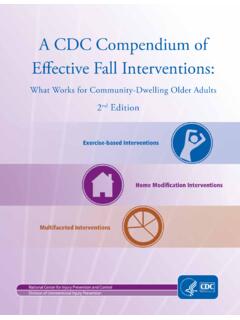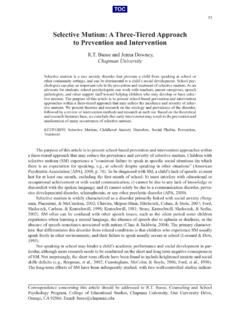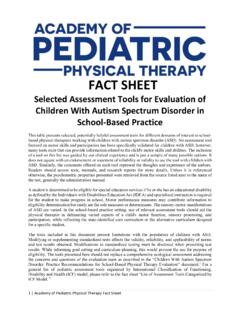Transcription of NHS STANDARD CONTRACT FOR SPECIALISED EATING …
1 1 NHS England/C01/S/a NHS Commissioning Board, 2013 The NHS Commissioning Board is now known as NHS England C01/S/a NHS STANDARD CONTRACT FOR SPECIALISED EATING DISORDERS (ADULTS) SCHEDULE 2 THE SERVICES - SERVICE SPECIFICATIONS Service Specification No. C01/S/a Service SPECIALISED EATING Disorders (Adults) Commissioner Lead Provider Lead Period 2013/14 Date of Review 1. Population Needs National/local context and evidence base The majority of people with EATING disorders fall into the following categories: Anorexia Nervosa Bulimia Nervosa EATING Disorder not otherwise specified (EDNOS) which includes Binge EATING Disorder.
2 This service specification covers intensive treatments (inpatient and intensive day-patient) for anorexia nervosa and very occasionally severe bulimia nervosa. It does not cover community EATING disorder services commissioned by CCGs. It should be noted that there may be changes over time in the diagnostic presentation of individual sufferers. Anorexia Nervosa Individuals with Anorexia Nervosa restrict their food intake to a severe degree resulting in significant weight loss. This may be accompanied by other abnormal weight control mechanisms such as excessive exercise, self-induced vomiting, or laxative misuse. Sufferers are typically pre-occupied with a drive for thinness, a fear of fatness, feelings of guilt associated with EATING and distortion of their body image.
3 Some people will not have these typical weight and shape concerns, and will express atypical over valued ideas, fear of, or preoccupation with being feeling 2 NHS England/C01/S/a NHS Commissioning Board, 2013 The NHS Commissioning Board is now known as NHS England full or bloating,, to explain their weight loss. Onset is typically in teenage years or early twenties. The majority of sufferers are women, although around 10% are men. Anorexia Nervosa is associated with significant physical and psychiatric co-morbidity. Mortality rates for the disorder increase with chronicity and aggregate mortality rates are estimated at per decade.
4 Severe Anorexia Nervosa is defined in weight terms as an individual with a body mass index (BMI) of <15 (BMI weight in kilograms divided by height in metres squared). Clearly other factors such as rapidity of weight loss and metabolic disturbance due to starvation or purging behaviours in addition to BMI determine medical risk and therefore consideration for admission. The majority of people suffering from anorexia nervosa including those with a BMI of 15 and under can be successfully treated in community by outpatient EATING disorder services. Only a small minority of those suffering from severe anorexia nervosa require inpatient treatment. Men can be physically compromised, hypothermia, weakness at a relatively higher BMI and therefore there should be a lower threshold for consideration for possible admission.
5 Mild/moderate Anorexia Nervosa is defined as an individual with a BMI of where the condition is stable and there is a lower risk of rapid deterioration. The lifetime prevalence of anorexia nervosa in young women is (average ) with an annual incidence in primary care of 14 per 100,000 in young women (Currin et al 2005). Expressed in terms of the whole population the incidence of anorexia nervosa per 100,000 of population is reported as between in the UK and in Denmark. (Smink et al 2012). The annual incidence of anorexia nervosa in men is less than 1 per 100,000 of population. Whilst the peak age of anorexia nervosa is in the mid teens, most sufferers fall within the age range of adult services.
6 There is an increased prevalence of anorexia nervosa and bulimia nervosa in gay men but no increased risk in lesbian women. (Meyer et al 2007). Bulimia Nervosa Bulimia Nervosa is characterised by cycles of binge- EATING , alternating with compensatory episodes of purging/over-exercising/or food restriction. Binge EATING is associated with a sense of loss of control, emotional distress and shame. Bulimia nervosa may be associated with significant physical risk including life threatening electrolyte disturbances there are also a significant number of other physical sequalae associated with the condition. Bulimia nervosa is also associated with significant psychiatric co-morbidity, notably anxiety disorders, depression, impulse control disorders and substance misuse disorders (Hudson et al 2007) and is often accompanied by many symptoms of wider physical and psychological discomfort and stress.
7 Sufferers with bulimia nervosa are of normal weight or in the overweight range. In community-based studies, the prevalence of bulimia nervosa has been estimated between and 1% in young women with an even social class distribution (Hay & 3 NHS England/C01/S/a NHS Commissioning Board, 2013 The NHS Commissioning Board is now known as NHS England Bacaltchuk, 2003). EATING Disorders not otherwise specified (EDNOS) and Binge EATING Disorder EDNOS is the most common form of EATING disorder. Sufferers may closely resemble people with Bulimia Nervosa and Anorexia Nervosa without fitting the criteria for the diagnosis exactly.
8 EDNOS is a disorder that may be as severe in presentation as that found in other diagnostic categories. Binge EATING Disorder is a specific sub set of EDNOS, whose sufferers tend to respond better to treatment. (The figures given for both prevalence and incidence should be treated with caution as they do not necessarily reflect the actual numbers of service users with the disorder presenting to services.) There is no reliable hard data on the proportion of people with an EATING disorder or anorexia nervosa who will require intensive inpatient specialist service input. We have therefore included an estimate, based on estimated bed usage and average length of stay in specialist EATING Disorder (ED) units (estimated as not all bed activity is known).
9 It is estimated that approximately 900 individuals need admission to Adult Inpatient services per year. (Population of England is 50 million, average length of stay is 18 weeks, Royal College Psychiatrists paper CR 170 recommends that 6 beds per million population is required). This equates to approximately 300 beds. Evidence base for EATING Disorders Mental Health National Service Framework. DH 1999 National Institute for Health and Care Excellence (NICE) Guidelines for EATING Disorders Jan 2004. Guidelines reviewed in 2010 and no new guidance from new data given. 4 NHS England/C01/S/a NHS Commissioning Board, 2013 The NHS Commissioning Board is now known as NHS England 2.
10 Scope Aims and objectives of service The aims of the service/s are to: Limit the physical and psychiatric morbidity, social disability and mortality levels caused by EATING disorders. Effectively treat people with very complex EATING disorders and /or severe morbidity Minimise the length of time between referral and admission to the inpatient service The specification covers the SPECIALISED service that is provided in an inpatient setting and intensive day patient settings, and a limited amount of outreach/outpatient work for people with very severe and intractable EATING disorders. Patients will have a diagnosable EATING disorder according to The Diagnostic and Statistical Manual of Mental Disorders version 4 (DSM1V) and/or The International Statistical Classification of Diseases and Related Health Problems version 10 (ICD 10) or its successor who require treatment for weight restoration or stabilisation or management of abnormal weight control mechanisms.















